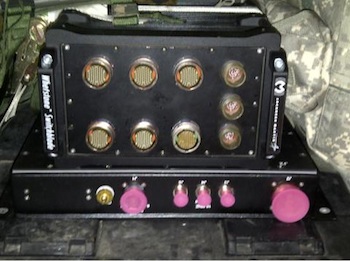Mobile Network in a Carrying Case Brings Warfighters Transportable Communications Capabilities
Warfighters around the world may soon be carrying around a case that contains a powerful and sophisticated suite of communications gear that can outfit military vehicles to make them more versatile and provide access to various networks without having to fill trucks with racks of equipment.

This “network in a box” is Lockheed Martin’s “Communications-on-the-Move” (COTM) Kit, a solution that incorporates servers, solid state storage, a network switch, and a router, and provides warfighters the ability to push various types of broadband data, such as satellite imagery down to small, company-level units that lack wideband connections.
The solution can equip vehicles with a communications link to satellite, Enhanced Position Location Reporting Systems, Single Channel Ground and Airborne Radio Systems and UHF/VHF Line of Sight. The system is platform agnostic and can be configured and tailored to meet changing mission requirements, eliminating the need for vehicles to be tailored specifically for mobile communications.
“Lockheed Martin offers the potential for each vehicle to be a network node without having to return to a depot for extensive installation of communications equipment,” said Jim Quinn, vice president of C4ISR Systems with Lockheed Martin IS&GS-Defense. “This kit offers warfighters a proven, transportable communications capability.”
According to Lockheed Martin, depending on the mission performed, the kit can be integrated from one platform to another in less than one hour. It is completely scalable, provides SATCOM connectivity and can support anything from small unit missions with critical voice, data and video mission command services to filling the communications needs for a brigade combat team command post with complete battle staff.
 While Lockheed Martin is the largest provider of IT services, systems integration, and training to the U.S. Government, this network in a box technology isn’t limited to military customers. A Lockheed Martin spokesperson told SecurityWeek that the product is available to anyone – military or civilian. The company is working with various customers to apply the technology to disaster relief, crisis management response and border patrol. Because the system utilizes satellite connectivity, the COTM kit is particularly valuable in situations where the existing communications infrastructure has been disrupted, such as is the case when earthquakes, hurricanes and other natural disasters occur.
While Lockheed Martin is the largest provider of IT services, systems integration, and training to the U.S. Government, this network in a box technology isn’t limited to military customers. A Lockheed Martin spokesperson told SecurityWeek that the product is available to anyone – military or civilian. The company is working with various customers to apply the technology to disaster relief, crisis management response and border patrol. Because the system utilizes satellite connectivity, the COTM kit is particularly valuable in situations where the existing communications infrastructure has been disrupted, such as is the case when earthquakes, hurricanes and other natural disasters occur.
Developed as a Lockheed Martin research and development project, the COTM kit was recently tested at the 2011 Joint Users Interoperability Communications Exercise. During the exercise, a larger scaled version of the kit showcased a tailored network infrastructure system that can insert additional functionalities to a third party system. The company says the kit is designated at Technological Readiness Level (TRL) 7, which means that the technology is sufficiently proven, and can be immediately incorporated into vehicles.
Related: The Veterans of the Future will be Those in Computer-Based Combat
Related: iPhone App Helps Train U.S. Army Patriot Missile Crews















